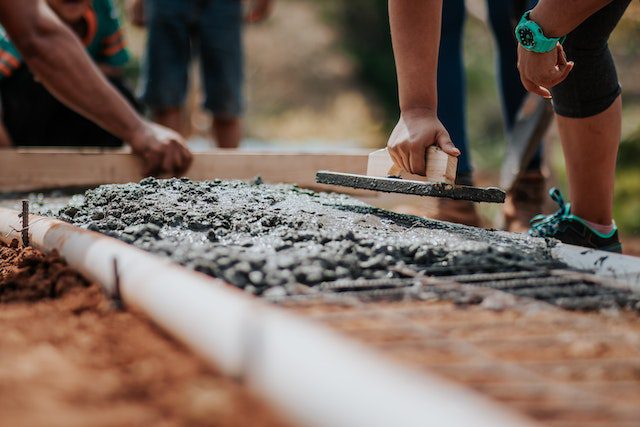
Signs the ‘perfect storm’ that hit Australia’s home-building sector is beginning to ease
An unprecedented “perfect storm” of factors that hit Australia’s home-building industry hard is beginning to ease, according to a major developer.
The combination of a Covid-induced supply chain crisis, skyrocketing materials costs, and a painful labour shortage have plagued the sector for the past 18 months.
A number of small and medium-sized companies went bust beneath the weight of heavy losses, which dented would-be buyer confidence.
And over the past several months, rapidly rising interest rates have presented a fresh challenge.
“It’s been quite tumultuous,” David Allt-Graham, general manager of residential projects at Melbourne-based developer MAB, said. “It’s really the perfect storm.”
Mr Allt-Graham said he hasn’t seen conditions as complex as these in the 20 years he’s worked in the property space.
After a tough run, there are signs that the ‘perfect storm’ that hit the residential construction sector is now easing. Picture: Getty
“The skills shortage has hit hard… that’s probably the number one issue impacting construction projects, with the supply chain of materials a close second.
“But yeah, in the past six to 12 months, finding builders and getting things at the right price has been really challenging.”
A slump in lending for new homes as well as falls in new building approvals and construction starts illustrates the extent of difficulties, Master Builders chief executive Denita Wawn said.
“Australia’s building and construction industry is one of the most sensitive parts of the economy to interest rate rises,” Ms Warn said.
“It continues to be impacted by product cost pressures and a shortage of tradespeople.”
Hidden within the official data, which produces often-bleak headlines, are glimmers of hope, Ms Wawn said.
In September, the Australian Bureau of Statistics numbers showed a “big gain” in approvals for apartments in high-rise buildings of nine storeys or more, for example.
On the ground, Mr Allt-Graham can also see green shoots that give him confidence about the broader sector.
“The feedback we’re getting from [our builders] is that supply chain pressures are easing, and costs are beginning to come down,” he said.
“Things like shipping, where the cost of containers had multiplied many, many times over, are starting to recover. Raw materials costs are on the right trajectory. Other areas, like fuel costs, are still challenged.
“But labour is the most pressing concern, and we haven’t really seen a turnaround in that job.”
The Federal Government’s recent jobs summit was welcomed by the construction sector, which has the lion’s share of need for skilled workers. A significant increase in skilled migrant numbers will help in the medium-term.
So, is that ‘perfect storm’ nearing an end?
“There are certainly bright patches,” Mr Allt-Graham said.
“We are very encouraged. We’ve got several active projects, three of which are coming out of the ground now.
“There’s one in Box Hill called Tempo, where we’ve had a couple of really good months of sales. The same is true for our Docklands project, Escala.
“We’re working on Preston Crossing, which is a precinct development in Preston with different stages of townhouses and apartments. That’s a very exciting village project.
“And we’ve got Merri Northcote down on Merri Creek and High Street, which is selling now and starts construction next year. It’s a fantastic project.”
And despite uncertainty in housing markets sparked by interest rate rises, Mr Allt-Graham said inquiry levels from first-home buyers and downsizers remains strong.
“So, all those things that are happening mean we’re quite encouraged.
Understandably, some prospective homebuyers might be hesitant to consider a new property given the events of the past few years.
For those Australians, Mr Allt-Graham had a simple message:
“The message is to invest in developers and builders who have a good track record and whose previous projects you can see. Understand their certainty of delivery. And do due diligence on the groups involved, which will be the best indication of successful delivery.”
Despite recent challenges, Master Builders forecasts a modest expansion of residential construction activity over the medium-term.
But Ms Wawn said the number of completed dwellings each year will be well short of the 200,000 new homes the government forecasts are needed to meet demand.
“While pandemic conditions brought forward some residential building demand, the current economic conditions of interest rates hikes, inflation increases, and continued shortages of workers and materials, are significantly contributing to the decline.”
That begs the question… what long-term changes are needed to improve conditions, not just for builders but for Australians who want and need a home?
“I think we need serious reform,” Mr Allt-Graham said.
“And it isn’t a simple or quick process, but fundamentally, planning reform, reforming some of the banking policy, and reforming taxes needs to happen to remove the impediments to getting projects done and delivered at a reasonable cost to consumers.
“Aside from supply chains and labour shortages and materials costs, I think the overriding thing that’s challenging is just that the world is more complex now. There’s a lot more regulation, both on the property industry but also through the banking industry.
“And that means those active in the market find it much harder to respond to all these other challenges because of the level of regulation is, to be honest, quite oppressive at times.”
Source: realestate.com.au/news